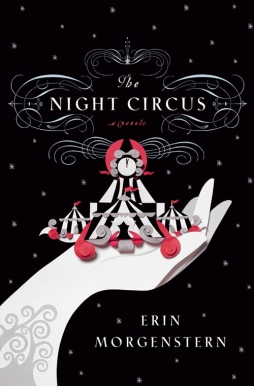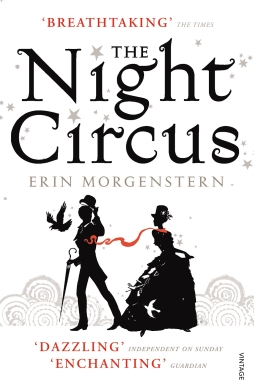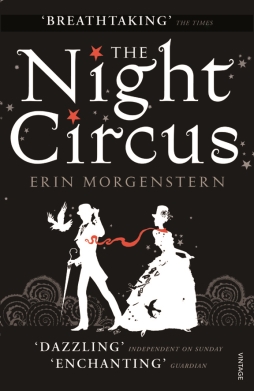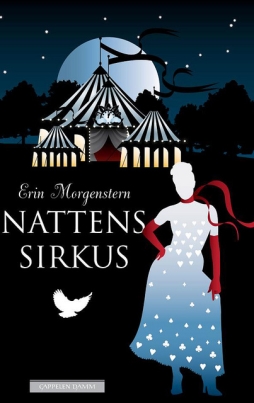The Opposite of the Uncanny: Wonder and The Night Circus
 ‘Magic’ is an elastic metaphor. Among its many possible uses is that of a descriptor for something that happens in performance, especially live performance: the magic of an actor possessed by a character, the magic of a given moment invested with wonder and remaining in the memory, though inevitably passing away. The magic of stage magicians isn’t in the sleight-of-hand; it’s in the effect on the audience. The related magic of the carnival — the amusement park, the theme park — is a kind of second-person secondary-world magic. You are there. You are in a conjured fantasyland. A circus, in this reading, isn’t about the stink of animals or the scutwork of putting up tents and preparing performance spaces; it’s about the feeling the show tries to inspire. It is, potentially, for some, a venue for magic — transient, susceptible to thinning, but capable of generating wonder.
‘Magic’ is an elastic metaphor. Among its many possible uses is that of a descriptor for something that happens in performance, especially live performance: the magic of an actor possessed by a character, the magic of a given moment invested with wonder and remaining in the memory, though inevitably passing away. The magic of stage magicians isn’t in the sleight-of-hand; it’s in the effect on the audience. The related magic of the carnival — the amusement park, the theme park — is a kind of second-person secondary-world magic. You are there. You are in a conjured fantasyland. A circus, in this reading, isn’t about the stink of animals or the scutwork of putting up tents and preparing performance spaces; it’s about the feeling the show tries to inspire. It is, potentially, for some, a venue for magic — transient, susceptible to thinning, but capable of generating wonder.
Which brings me to Erin Morgenstern’s 2011 novel, The Night Circus. Set in the years leading up to and just after the start of the twentieth century, it tells the story of a kind of duel between two magicians, fought by proxy through talented pupils. Both pupils are recruited at a young age, and brought up to compete in the contest knowing nothing about the nature of the duel, not the rules, not how to win, not even who their opponent is. But this much swiftly becomes clear to them: the scene for the contention will be a fantastical circus, Le Cirque des Rêves, travelling through the great cities of the world.
We follow the story through the eyes of both contestants: Celia, the circus’s magician, and Marco, who assists the (non-wizardly) man who puts the circus together — Marco doesn’t travel with Le Cirque des Rêves, but plans tents filled with magical effects. The duel, Marco and Celia soon realise, is based around rival performances: each striving to outdo the other in creating wonder, therefore building a circus, incidentally filled with other performers and obsessed fans, dedicated to art. As the story moves easily back and forth through time, we also get several other perspectives on events, brief chapters constructing an artful, patterned plot that resolves nicely at the climax. The highly-worked plot mirrors the highly-worked nature of the book. The writing aspires to elegance, sometimes perhaps too obviously, relying too much on single-sentence paragraphs, but always displaying a striking visual imagination.
Here’s a description of a clock, pointing to the book’s concern with time. Or, more precisely, this is a description of the changes that come to the clock. “At first glance,” we’re told, “it is simply a clock, a rather large black clock with a white face and silver pendulum.” But then the mechanism is set in motion, and changes happen over the course of hours:
The face of the clock becomes a darker grey, and then black, with twinkling stars where the numbers had been previously. The body of the clock, which has been methodically turning itself inside out and expanding, is now entirely subtle shades of white and grey. And it is not just pieces, it is figures and objects, perfectly carved flowers and planets and tiny books with actual paper pages that turn. There is a silver dragon that curls around part of the now visible clockwork, a tiny princess in a carved tower who paces in distress, awaiting an absent prince. Teapots that pour into teacups and miniscule curls of steam that rise from them as the seconds tick. Wrapped presents open. Small cats chase small dogs. An entire game of chess is played.
At the center, where a cuckoo bird would live in a more traditional timepiece, is the juggler. Dressed in harlequin style with a grey mask, he juggles shiny silver balls that correspond to each hour. As the clock chimes, another ball joins the rest until at midnight he juggles twelve balls in a complex pattern
Like the clock, the Cirque is a vision in white and black, silver and jet; though the Cirque proper has red highlights. Morgenstern, a multimedia artist, conveys it all nicely in her prose. There’s no literal magic in the clock, but it’s an example of how the writing evokes the magical: how it is sensitive to imagery. And to transformation. Again and again in the book one watches magic unfold, put in the position of audience to an unreal spectacle. Time seems to pause; as though a juggler were playing with it. So Morgenstern often steps back from the story to present brief second-person interludes describing some element of the circus and its rituals. It’s an effective device to bring out the magicians’ work, the masterpieces of art brought about by their duel; it complements and slightly overshadows the narrative — but while this would normally be a problem, in this case seems to get at the core of the book.
 I think fundamentally The Night Circus is an exercise in generating wonderment. That’s a difficult thing to do. It’s a difficult sense to generate in an audience without having it become twee or arch; one could perhaps view wonder as a liminal state, a delicate equilibrium which can be sustained for only so long. This may relate to John Clute’s theory of fantasy as subject to a cycle of thinning and healing, of diminution and restoration: like magic, wonder fades, sooner or later, but might return. As the Cirque des Rêves, a travelling show that appears mysteriously, moves on, returns: like time, revolving through day and night and summer and winter.
I think fundamentally The Night Circus is an exercise in generating wonderment. That’s a difficult thing to do. It’s a difficult sense to generate in an audience without having it become twee or arch; one could perhaps view wonder as a liminal state, a delicate equilibrium which can be sustained for only so long. This may relate to John Clute’s theory of fantasy as subject to a cycle of thinning and healing, of diminution and restoration: like magic, wonder fades, sooner or later, but might return. As the Cirque des Rêves, a travelling show that appears mysteriously, moves on, returns: like time, revolving through day and night and summer and winter.
The Night Circus is a steampunk story, fantastical Victoriana; it occurs to me, having read it, that perhaps steampunk strikes a chord for contemporary readers specifically because it generates wonder in some way that’s immediately accessible for the current day. If so, then from a certain point of view, The Night Circus is essential steampunk. It’s concerned with artifice and beauty (I’d argue that in this it’s unlike actual punk, which always struck me as opposed to craft and, at least originally, opposed to theatricality). Perhaps one could consider steampunk a way of finding beauty — wonder, the fantastic — in the industrial era. That is, not in a natural or pastoral setting like much traditional fantasy, and not in an imagined future like science fiction, but in a setting as divorced from the natural world as our own, one we recognise.
Is the recognition important? Wonder’s said to be dreamlike, which is true and untrue. Obviously it’s true in that it’s as strange as a dream. I think it’s untrue, though, in that there’s a consciousness to wonderment. I think when strange things happen in dreams, they’re usually accepted as normal; the sense that they’re strange, at least for me, is usually a sign that either the dream’s moving on from that image or else that the dream as a whole is near its end. Wonder, though, relies on a consciousness of itself: when enraptured, we know how it is we feel. It’s not just a kind of awe, but a consciousness of awe. It may be the opposite of the uncanny.
 At any rate, here it’s part of the theatrical illusion, or of a theatrical illusion. It’s a kind of theatricality with which The Night Circus is greatly concerned; which is to say, not drama but coups de theatre. Not the theatricality of Lear entering with dead Cordelia in his arms, but the theatricality of the statue of Hermione coming to life: the book’s a winter’s tale. It’s a romance, in the Shakespearean sense, not a tragedy, and not really a comedy (for it’s difficult to get wonder to co-exist with most types of humour, particularly earthy knockabout gags; Rabelais’ giants are occasionally convincing as giants, but seem to me to be least funny at their most wonderful). At any rate, given that one of the magicians is named Prospero, the element of Shakespearean romance is clear. And this is what I mean when I say that a lack of drama that might be a problem in other books is acceptable here. The book is a performance: a performance in prose.
At any rate, here it’s part of the theatrical illusion, or of a theatrical illusion. It’s a kind of theatricality with which The Night Circus is greatly concerned; which is to say, not drama but coups de theatre. Not the theatricality of Lear entering with dead Cordelia in his arms, but the theatricality of the statue of Hermione coming to life: the book’s a winter’s tale. It’s a romance, in the Shakespearean sense, not a tragedy, and not really a comedy (for it’s difficult to get wonder to co-exist with most types of humour, particularly earthy knockabout gags; Rabelais’ giants are occasionally convincing as giants, but seem to me to be least funny at their most wonderful). At any rate, given that one of the magicians is named Prospero, the element of Shakespearean romance is clear. And this is what I mean when I say that a lack of drama that might be a problem in other books is acceptable here. The book is a performance: a performance in prose.
I think certain things come along with that. To start with, the lack of drama might wrong-foot readers used to clearly-defined struggles for clearly-defined stakes. In fact, the book seems to take great delight in keeping the nature of the duel unclear for as long as possible, which I think is a strong choice. The story’s also inherently anti-realistic: instead of building a clearly-defined society, and shaping characters based on that context, the overall society’s only vaguely established. There’s nothing here about Victorian attitudes toward women, nothing significant about class or race or technological progress or European militarism or American isolationism.
More broadly, the characters feel curiously vestigial, as though lacking past or future or connection to that wider world. Their feelings are strong at any given moment, their reaction to art or the marvels of the circus; but the feel of that moment seems to be all. This is not necessarily a criticism. I think again it’s a function of the depiction, and the instilling, of wonder: a dropping-away of context, of what has been or will come, in order to focus on the present moment of awe — a kind of transcendence.
 But what about the other people shaped by the actions of the main characters? Other folk are shaped by the circus, are killed or have their lives ruined by the duel or by the actions the magician characters take. But they only ever seem peripheral. I think that’s intentional; I think Morgenstern’s hinting at a real darkness that’s meant to become more dreadful from being understated. I think also it implies the potential problem with a focus on wonder above all: the detachment from consequences.
But what about the other people shaped by the actions of the main characters? Other folk are shaped by the circus, are killed or have their lives ruined by the duel or by the actions the magician characters take. But they only ever seem peripheral. I think that’s intentional; I think Morgenstern’s hinting at a real darkness that’s meant to become more dreadful from being understated. I think also it implies the potential problem with a focus on wonder above all: the detachment from consequences.
All these things being said, there are I think some flaws in the book, even to a reader for whom it’s successful in generating wonder. I think some of the symbols in the book are used too easily, without enough grounding. For example, tarot imagery is a strong element in the novel — as with the juggler, the first trump, at the centre of the clock — but given the many possible meanings attributable to each tarot image, it’s difficult to work out what the relevance of a given card may be (plus, the book describes images from the Rider-Waite deck, which wasn’t drawn up until several years after the story takes place). Similarly, Shakespearean echos abound, but don’t seem to point a way deeper into the book; they feel unsubtle. There is overall a feeling of a lack of depth to the book; or, more precisely, that the depth that you first see in it is one of the many artifices of the circus.
That may be unfair. Or it may be because there’s so much in the book, so many symbols in so many patterns, that it would be impossible to unify all the resonances into a whole. Certainly the book does succeed in maintaining its atmosphere. Everything’s glamorous, in the full sense of that word. What may be most fascinating is that characters gain in glamour when seen from outside; when we’re privy to their doubts and fears, we see backstage, and the magic changes quality. It’s a transition Morgenstern handles nicely.
What, in the end, is the book about? What themes does it juggle? It’s about love, I think, as it’s a love story that drives the book and inspires the art. Art, that’s also a theme: art and theatre. It’s about oppositions, white and black, and interstitial spaces where they co-exist; like the stage, like the Cirque des Rêves itself. It’s about time, and transience. It’s about wonder, and maintaining the sense of wonder in the face of onrushing time as artists lose themselves in their art. It’s about wizards, locked up in trees.
It may be about something less than all this. But it also may be all these things and more.
Matthew David Surridge is the author of “The Word of Azrael,” from Black Gate 14. His ongoing web serial is The Fell Gard Codices. You can find him on facebook, or follow his Twitter account, Fell_Gard.